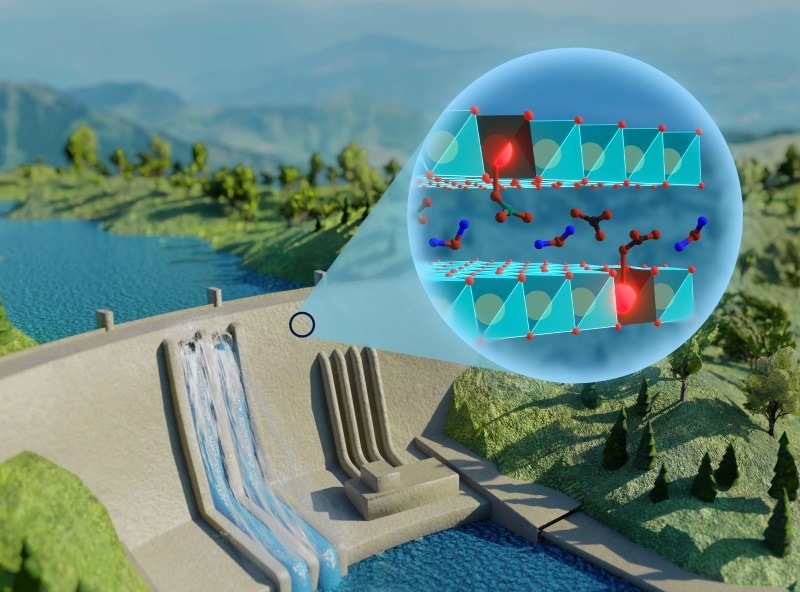In the construction industry, concrete is a necessary material for many infrastructure projects, including highways, bridges, dams, and office buildings, as well as the foundations and superstructure of these buildings. But concrete has a limited service life, therefore it needs to be watched upon to ensure these constructions stay secure.
 The innovative method not only contributes to maintenance of building safety but also offers potential benefits in terms of two other important aspects of present-day economies: costs, and carbon reduction. Image Credit: Danilo Mustafa
The innovative method not only contributes to maintenance of building safety but also offers potential benefits in terms of two other important aspects of present-day economies: costs, and carbon reduction. Image Credit: Danilo Mustafa
Researchers at the Physics Institute of the University of São Paulo (IF-USP) in Brazil, working with colleagues at the University of Leuven in Belgium, have created a luminescent material that discloses the presence of compounds suggesting deterioration of concrete when exposed to ultraviolet light. This material can be used for quick, inexpensive, in-situ analysis, eliminating the need to take samples to a laboratory.
The findings are reported in an article on the journal’s front cover and in Chemical Communications.
An average concrete construction lasts for fifty years. Acidification, brought on by the continuous absorption of water, salts, and gases from the environment, corrodes the steel reinforcing bars (rebars) in slabs, columns, and other structural components, significantly lowering their weight-bearing capability.
Preventive methods, such as adding protective coatings to exposed surfaces of structures to impede carbon dioxide (CO2) penetration, can prolong the lifespan of concrete. The capacity to confirm and describe the level of deterioration is essential if this intervention is to be implemented on time.
Engineers who assess the condition of concrete in buildings and other structures have several challenges, prominent among them being the labor-intensive and expensive nature of drilling samples and the complexity of laboratory analysis required in difficult-to-reach locations.
Additionally, it could be dangerous since improper execution of the process might result in structural changes and further deteriorate already-degraded concrete.
The Nanomaterials and Applications Laboratory (LNA) at IF-USP established a catalyst based on layered double hydroxide (LDH), also known as anionic clay, to determine the degree of deterioration in concrete. This study was funded by FAPESP (projects 15/19210-0, 18/13837-0, 19/25665-1, and 22/01314-8). They produced orange-to-red luminescence by adding trivalent europium (Eu3+).
According to laboratory experiments, the material’s luminescence changed color in response to ultraviolet light (UV) based on how much carbonate it had absorbed. Concrete degradation can be identified using this effect: the more damaged the concrete, the bigger the quantity of carbonate and the greater the redshift.
The main advance is that the material can help determine in real time how the concrete present in a structure is deteriorating and when the structure will require maintenance, without any need for drilling or waiting for laboratory analysis. This contributes to more agile decision-making, facilitates preventive maintenance, and helps avoid accidents that can cost lives and cause considerable economic damage.
Alysson Ferreira Morais, Study First Author and Postdoctoral Fellow, Katholieke Universiteit Leuven
During the study, he was financed by FAPESP through a postdoctoral fellowship.
According to the experts, the next stage will be to create a sensor that detects the luminescent substance and tests it under real-world situations to ensure certain aspects, such as weatherability and stability within concrete.
Safety, Cost and Carbon Footprint
Apart from enhancing building safety, the novel approach can potentially yield advantages concerning two other crucial facets of contemporary economies: expenses and carbon mitigation.
The longer buildings last, the less need to invest in new structures, and the more the construction industry contributes to the effort to cut greenhouse gas emissions, 8% of which come from the industry globally, owing to the production of concrete and construction itself.
Danilo Mustafa, Study Lead Author and Professor, University of São Paulo’s Physics Institute
Researchers from the University of Kiel in Germany also participated in the study, which was funded by FAPESP as well as CAPES, the Brazilian Ministry of Education’s Coordination for the Improvement of Higher Education Personnel; the European Research Council; and the European Union’s Horizon Europe Program.
Journal Reference:
Morais, A. F., et. al. (2024) Eu3+ doped ZnAl layered double hydroxides as calibrationless, fluorescent sensors for carbonate. Chemical Communications. doi:10.1039/D3CC03066K